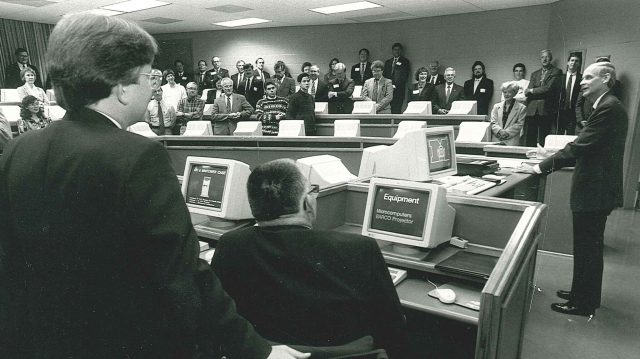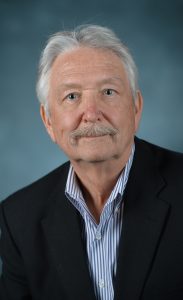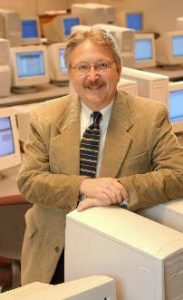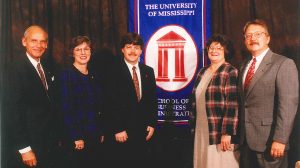
Del Hawley (standing, left) listens as Dean Randy Boxx speaks at the 1993 dedication of the first interactive computer classroom at the university. Hawley, who retires at the end of this year, was a major player in getting the new lab up and running. Submitted photo
OXFORD, Miss. – When Del Hawley arrived at the University of Mississippi, Ronald Reagan was president, gasoline cost 86 cents a gallon and the Dow Jones Industrial Average was 1,793. No one could have imagined – least of all, Hawley – what the next 35 years would bring.
In August 1986, he left East Lansing, Michigan, alone to start the fall semester at Ole Miss. He had planned to return to Michigan over the Labor Day weekend to move his wife, Rita, and their 9-month-old daughter to Oxford. Until then, he was staying at the Alumni House because their new home was not finished.
On Friday, at the end of his first week, feeling lonely, missing his wife and daughter, Hawley decided to walk up to the Chevron station to get a six-pack of beer but discovered people couldn’t buy cold beer in Oxford. He had accepted a job in a “dry” county in Mississippi.
“What kind of place is this, and what have I gotten myself into?” he thought.
Despite a disorienting start, the School of Business Administration had just made a hire who would quietly lead; participate in innovations in teaching with technology, shifts and growths in learning; and serve at the helm of the construction of Holman Hall, the business school’s home for nearly three decades.
After 35 years at the school, Hawley is retiring at the end of the year.
He began leaving his mark right away. It was the dawn of the computer age when he was spotted in 1987 wheeling a Zenith personal computer, connected to a huge Sony video projector, to display financial spreadsheets. It was nothing exceptional by today’s standards, but it was considered cutting edge and revolutionary at that time.
Innovation Begins
In the late 1980s, a group of young professors, including Hawley, Phil Malone, Joe Paolillo and Keith Womer, were leading the school into a new decade under the leadership of Dean Rex Cottle.

After 35 years on the faculty of the School of Business Administration, Del Hawley is retiring at the end of the year. Photo by Kevin Bain/Ole Miss Digital Imaging Services
Malone, a finance professor, and Hawley took advantage of a program called the UM Associates Grant program and bought computers and printers, and used them in a lab for shared equipment in Conner Hall. Soon thereafter, the business school built and housed its first computer work lab for the faculty, which was the beginning of regular use of technology in teaching.
As they entered the new decade in August 1991, they welcomed another young professor, Brian Reithel, from the University of South Florida, to the management information systems program. Shortly after that, Hawley, Malone and Reithel installed network wiring and systems to connect the faculty offices in Conner Hall.
In 1993, right after Hawley was appointed associate dean, the school launched the first PC-based email system on campus. This was a breakthrough in higher learning globally. Cornell University had a system in place, but it was very unusual for an academic unit, such as the business school, to have its own email server.
Then, in the fall of 1994, Bart Garner came from California and was hired to serve as the first network administrator for a separate unit on the Ole Miss campus.
Building Holman Hall
Beginning in 1961, Conner Hall was home to the business school. As the school grew alongside the accountancy program, it couldn’t house all the faculty and students enrolled.
In early 1995, conversations began about expanding the building. This was referred to as the “programming phase.” However, there were some delays in breaking ground, and by the middle of 1996 construction was underway.

Del Hawley proudly shows off computers in Conner Hall, Room 13, just after the renovation of the building was completed in 1998. This was one of two computer classrooms included in the new construction. Submitted photo
Initially, there was not enough funding to finish out the third floor of either building. Then, the Patterson and Holman gifts came in and allowed both buildings to be completed.
Garner and Hawley were very involved in technology for the building. Garner was very forward-thinking in the areas of instructional technology to support the faculty and give them tools to do their best work.
“Del and others had a vision of new technology for the school,” Garner said. “He and Brian had been to other institutions and were very aware of the new technologies.
“The new building and renovation of Conner Hall gave us a chance to be on the cutting edge of classroom and networking technology.”
The Holman renovation was completed in 1997 and Conner in 1998. When the project was finished, the university had renovated and erected a state-of-the-art learning center with more than 100 miles of cable and 2,000 network connections throughout the complex, two 45-seat computer classrooms, and a distance-learning center with two interactive video conference classrooms and a control center.
A Mentor and a Friend
In 2000, Sam Hammoud, a young man from Lebanon, left his home city of Beirut to travel some 10,000 kilometers to join his brother at Ole Miss. He first encountered Hawley at his graduation in 2006; Hawley was reading the names of the graduates.
“He actually pronounced my name correctly,” Hammoud said with a laugh. “After I received my diploma, I slipped him my card.”
After a short time in the private sector, Hammoud decided he’d like to return to the university to work in information technology. A former teacher suggested he go see Hawley, so he headed to the business school, resume in hand, and cold-called Hawley by knocking on his door unannounced.
Hawley looked over the paper and said, “I’ve been looking for a person with your skills.”
Hammoud has worked with Hawley for more than a decade.
“Del is the ultimate professional in the office,” he said. “He inspires me to work as hard as I do because he values that in people. He has been a friend, a mentor, and I trust him with all that I have professionally and personally.”
Hammoud received his U.S. citizenship in 2019, concluding a 20-year quest to become an American citizen.
“Del stayed with me through the process and never gave up regardless of how tedious or bureaucratic things got,” he said. “I will always be grateful for his support during that time.”
One of the hallmarks of Hawley’s legacy will be his fairness and respect of everyone who has had the opportunity to work with him. He empowers faculty and staff to be their best by giving them the tools to succeed.
“Helping the business school get better and stronger year after year has always been my greatest joy and honor,” Hawley said. “But it’s always important to remember that the business school is not the building or the furniture or the technology.
“It’s the people. It’s all of the people who give their time and effort to work with all of the other team members to make our business school the best that it can be.”
Leaving a Legacy
“Del has become the ultimate collegiate business school administrator,” Reithel said. “He is trusted, respected, thoughtful, seasoned and extraordinarily effective.

Randy Box (left), dean of the UM School of Business Administration; Ann Canty, assistant dean; Brian Reithel, co-chair of the university’s sesquicentennial celebration; Sue Hodge, the school’s director of advising; and Del Hawley, associate dean, show off the school’s new sesquicentennial banner in December 1999. Submitted photo
“His service as senior associate dean has helped the Ole Miss School of Business become a nationally-recognized leader in undergraduate, master’s and doctoral education.”
Hawley’s impact and legacy have not gone unnoticed, and he has been instrumental in moving the business school forward. All who have worked with him realize his competency and abilities throughout many different challenges for more than three decades.
“Del is an institution at the business school” said Dean Ken Cyree, who has worked with Hawley for 14 years as dean and 17 years as a finance faculty member. “While no fan of bureaucracy, he has amazing institutional knowledge and is able to get things done that no one else can, because he knows who to call when something needs to be done. He is a very selfless person and truly wants what is best for the school and all the people who work here.
“I have always admired and respected the fairness he demonstrates in decision making and the support he has provided me even if we disagree on a matter. He is leaving this place better than he found it and that is always a testament to someone’s resiliency and hard work.”
As Hawley steps into retirement after three-and-a-half decades of service, there is no denying much has changed for the better since his arrival. He has served under five chancellors and six deans. Through it all, he has worked quietly, behind-the-scenes, to make extraordinary transformations possible.
“Our tremendous faculty and staff members are the reason our business school is unique and exceptional,” Hawley said as his farewell to an institution he helped mold through innovation, hard work and quiet leadership. “I am proud to have been able to serve on a team with so many wonderful people for so many years.”